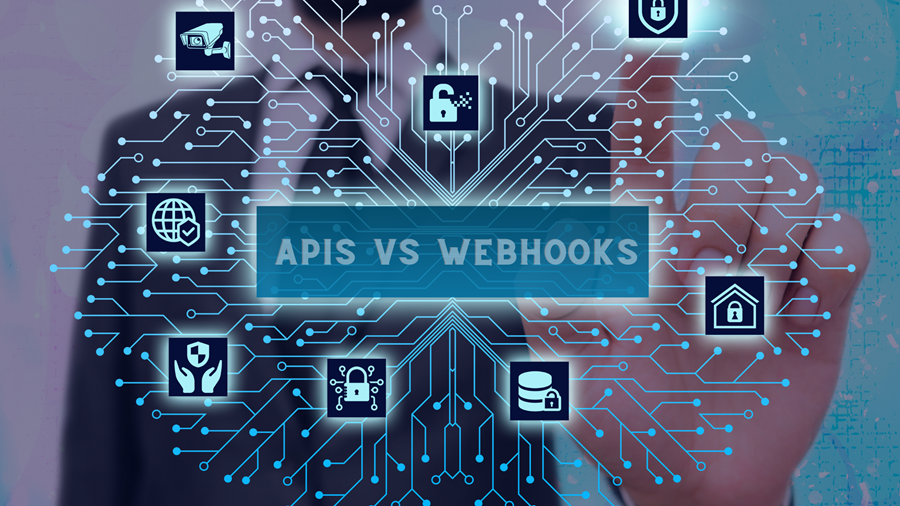APIs vs Webhooks
We are living in an era where every enterprise has to deliver faster services to its customers. As modern web development evolves at a rapid pace, the need to communicate effectively with customers has taken the driver’s seat. To meet this pressing need, it is essential to make technologies talk to each other. And that’s where APIs and Webhooks play a major part.
Unfortunately, even today, people use these two terms interchangeably in tools documentation and technical articles without actually knowing how different they are. Both webhooks and APIs have different modus operandi and are used for different purposes.
In this post, we will take a look at both these concepts, when to use each of them, and their key differences.
Table of Contents
- What are APIs?
- What are Webhooks?
- When to use APIs?
- When to use Webhooks?
- Conclusion
What are APIs?
API stands for Application Programming Interface. In layman’s terms, it is a set of rules that enables one piece of software to communicate with another piece of software. The first software calls the API by sending a request for a service. The second software then returns the requested service by providing a response through the API. The response could be anything - a piece of data or even an error message in case something went wrong.
Here’s a simple analogy to explain APIs.
Imagine you are at a restaurant. You want to order food. Now, one way to go about this is to go into the kitchen and make the food yourself. The easier way is to tell the waiter what you want to eat.
Here, You are the first software requesting a service(food). The restaurant is the second software providing you with the service. The waiter is the API that provides you with a way to request the service.
The waiter takes your order, passes it on to the chef, and finally brings you the food once it's ready.
What are Webhooks?
A webhook is a technique where an application offers information in real-time to another application when a particular event happens. Webhooks are also called reverse APIs because, unlike APIs, the communication is initiated by the application sending the information instead of the one receiving it. For instance, you can use a Webhook to notify your CRM system when a new customer signs up on your website.
Let us explain Webhooks with the same restaurant analogy.
Imagine you are at the same restaurant. You have placed the order, and you want to know whether the food is ready. One way to go about this is to constantly badger the waiter and ask them whether the food is ready yet. This is like an API where you constantly poll to check if a specific event has occurred.
The more efficient way is to give your phone number to the waiter and have them text you once the food is ready. This is like a Webhook where you provide where you create a way for the restaurant to send a notification as soon as the event(food getting ready) occurs.
When to use APIs?
Here are three situations when you want to use APIs -
- When you want to request specific information from a particular system.
- When you want to request specific information on demand (instead of real-time).
- When you want to perform an action on another system, such as creating, updating, or deleting data.
Here are three real-life examples where you use an API -
- You are building a weather app. You want to connect it with a weather forecasting service. You can use an API to request the current weather data for a particular location.
- You are building an online store. You want to connect it with a payment processing solution. You can use an API to submit the payment details and process the transactions.
- You are building a social platform. You want to connect it with a translation solution to automatically translate every post. You can use an API to request these translations on demand.
When to use Webhooks?
Here are three situations when you want to use Webhooks -
- When you want to get notified as soon as an event happens in another system
- When you want real-time updates from another system
- When you want to avoid the constant polling of another system for updates
Here are three real-life examples where you use Webhooks -
- You are building a customer service chatbot. You want to be notified as soon as a visitor sends a message. You can use a Webhook to get notified as soon as the message is received.
- You are building a stock trading platform. You want real-time updates on stock prices. You can use a Webhook to get updated as soon as the prices changes.
- You are building a project management tool. You want a notification as soon as a team member completes a task. You can use a Webhook to get notified as soon as the task is marked ‘complete.’
Conclusion
As you have seen in this post, both APIs and Webhooks are equally valuable when it comes to integrating and exchanging data between two systems. While APIs revolve around the traditional request-response model, Webhooks offer a more efficient approach as it allows the receiving system to proactively push the data to the requesting system in real time. Also, APIs are more widely used and easier to implement than Webhooks, which are a better choice in certain situations. Long story short, the choice between API or Webhook totally depends on the needs of your project.
